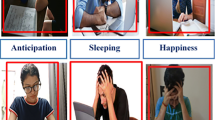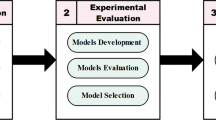Abstract
Student engagement is an important factor in meeting the goals of virtual learning programs. Automatic measurement of student engagement provides helpful information for instructors to meet learning program objectives and individualize program delivery. Many existing approaches solve video-based engagement measurement using the traditional frameworks of binary classification (classifying video snippets into engaged or disengaged classes), multi-class classification (classifying video snippets into multiple classes corresponding to different levels of engagement), or regression (estimating a continuous value corresponding to the level of engagement). However, we observe that while the engagement behavior is mostly well defined (e.g., focused, not distracted), disengagement can be expressed in various ways. In addition, in some cases, the data for disengaged classes may not be sufficient to train generalizable binary or multi-class classifiers. To handle this situation, in this paper, for the first time, we formulate detecting disengagement in virtual learning as an anomaly detection problem. We design various autoencoders, including temporal convolutional network autoencoder, long short-term memory autoencoder, and feedforward autoencoder using different behavioral and affect features for video-based student disengagement detection. The result of our experiments on two publicly available student engagement datasets, DAiSEE and EmotiW, shows the superiority of the proposed approach for disengagement detection as an anomaly compared to binary classifiers for classifying videos into engaged versus disengaged classes (with an average improvement of 9% on the area under the curve of the receiver operating characteristic curve and 22% on the area under the curve of the precision–recall curve).


Similar content being viewed by others
Data Availability
The datasets analyzed during the current study are publicly available in the following repositories: https://people.iith.ac.in/vineethnb/resources/daisee/index.htmlhttps://sites.google.com/view/emotiw2020/
References
Dhawan, S.: Online learning: a panacea in the time of COVID-19 crisis. J. Educ. Technol. Syst. 49(1), 5–22 (2020)
Dumford, A.D., Miller, A.L.: Online learning in higher education: exploring advantages and disadvantages for engagement. J. Comput. High. Educ. 30(3), 452–465 (2018)
Sümer, Ö., Goldberg, P., D’Mello, S., Gerjets, P., Trautwein, U., Kasneci, E.: Multimodal engagement analysis from facial videos in the classroom. IEEE Trans. Affect. Comput. (2021). https://doi.org/10.1109/TAFFC.2021.3127692
Sinatra, G.M., Heddy, B.C., Lombardi, D.: The challenges of defining and measuring student engagement in science. Taylor & Francis, UK (2015)
D’Mello, S., Dieterle, E., Duckworth, A.: Advanced, analytic, automated (AAA) measurement of engagement during learning. Educ. Psychol. 52(2), 104–123 (2017)
Woolf, B., Burleson, W., Arroyo, I., Dragon, T., Cooper, D., Picard, R.: Affect-aware tutors: recognising and responding to student affect. Int. J. Learn. Technol. 4(3/4), 129–164 (2009)
Dewan, M., Murshed, M., Lin, F.: Engagement detection in online learning: a review. Smart Learn. Environ. 6(1), 1–20 (2019)
Doherty, K., Doherty, G.: Engagement in HCI: conception, theory and measurement. ACM Comput. Surv. (CSUR) 51(5), 1–39 (2018)
Abedi, A., Khan, S.S.: Improving state-of-the-art in detecting student engagement with resnet and TCN hybrid network. In: 2021 18th Conference on Robots and Vision (CRV), IEEE, pp. 151–157 (2021)
Aung, A.M., Whitehill, J.: Harnessing label uncertainty to improve modeling: an application to student engagement recognition. In: FG, pp. 166–170 (2018)
Chen, X., Niu, L., Veeraraghavan, A., Sabharwal, A.: FaceEngage: robust estimation of gameplay engagement from user-contributed (YouTube) videos. IEEE Trans. Affect. Comput. 13(2), 651–65 (2019)
Booth, B.M., Ali, A.M., Narayanan, S.S., Bennett, I., Farag, A.A.: Toward active and unobtrusive engagement assessment of distance learners. In: 2017 Seventh International Conference on Affective Computing and Intelligent Interaction (ACII), IEEE, pp. 470–476 (2017)
Gupta, A., D’Cunha, A., Awasthi, K., Balasubramanian, V.: Daisee: Towards user engagement recognition in the wild. arXiv preprint arXiv:1609.01885 (2016)
Mehta, N.K., Prasad, S.S., Saurav, S., Saini, R., Singh, S.: Three-dimensional densenet self-attention neural network for automatic detection of student’s engagement. Appl. Intell. 52(12), 13803–23 (2022)
Abedi, A., Khan, S.: Affect-driven engagement measurement from videos. arXiv preprint arXiv:2106.10882 (2021)
Liao, J., Liang, Y., Pan, J.: Deep facial spatiotemporal network for engagement prediction in online learning. Appl. Intell. 51(10), 6609–6621 (2021)
Huang, T., Mei, Y., Zhang, H., Liu, S., Yang, H.: Fine-grained engagement recognition in online learning environment. In: 2019 IEEE 9th International Conference on Electronics Information and Emergency Communication (ICEIEC), IEEE, pp. 338–341 (2019)
Ma, X., Xu, M., Dong, Y., Sun, Z.: Automatic student engagement in online learning environment based on neural turing machine. Int. J. Inf. Educ. Technol. 11(3), 107–111 (2021)
Dresvyanskiy, D., Minker, W., Karpov, A.: Deep learning based engagement recognition in highly imbalanced data. In: International Conference on Speech and Computer, Springer, pp. 166–178 (2021)
Thomas, C., Nair, N., Jayagopi, D.B.: Predicting engagement intensity in the wild using temporal convolutional network. In: Proceedings of the 20th ACM International Conference on Multimodal Interaction, pp. 604–610 (2018)
Kaur, A., Mustafa, A., Mehta, L., Dhall, A.: Prediction and localization of student engagement in the wild. In: 2018 Digital Image Computing: Techniques and Applications (DICTA), IEEE, pp. 1–8 (2018)
Copur, O., Nakıp, M., Scardapane, S., Slowack, J.: Engagement detection with multi-task training in e-learning environments. In: International Conference on Image Analysis and Processing, Springer, pp. 411–422 (2022)
Aslan, S., Mete, S.E., Okur, E., Oktay, E., Alyuz, N., Genc, U.E., Stanhill, D., Esme, A.A.: Human expert labeling process (HELP): towards a reliable higher-order user state labeling process and tool to assess student engagement. Educ. Technol. 57, 53–59 (2017)
Ranti, C., Jones, W., Klin, A., Shultz, S.: Blink rate patterns provide a reliable measure of individual engagement with scene content. Sci. Rep. 10(1), 1–10 (2020)
Khan, S.S., Abedi, A., Colella, T.: Inconsistencies in measuring student engagement in virtual learning–a critical review. arXiv preprint arXiv:2208.04548 (2022)
Thill, M., Konen, W., Wang, H., Bäck, T.: Temporal convolutional autoencoder for unsupervised anomaly detection in time series. Appl. Soft Comput. 112, 107751 (2021)
Bosch, N.: Detecting student engagement: human versus machine. In: Proceedings of the 2016 Conference on User Modeling Adaptation and Personalization, pp. 317–320 (2016)
Niu, X., Han, H., Zeng, J., Sun, X., Shan, S., Huang, Y., Yang, S., Chen, X.: Automatic engagement prediction with gap feature. In: Proceedings of the 20th ACM International Conference on Multimodal Interaction, pp. 599–603 (2018)
Wu, J., Yang, B., Wang, Y., Hattori, G.: Advanced multi-instance learning method with multi-features engineering and conservative optimization for engagement intensity prediction. In: Proceedings of the 2020 International Conference on Multimodal Interaction, pp. 777–783 (2020)
Toisoul, A., Kossaifi, J., Bulat, A., Tzimiropoulos, G., Pantic, M.: Estimation of continuous valence and arousal levels from faces in naturalistic conditions. Nature Mach. Intell. 3(1), 42–50 (2021)
Mollahosseini, A., Hasani, B., Mahoor, M.H.: AffectNet: A database for facial expression, valence, and arousal computing in the wild. IEEE Trans. Affect. Comput. 10(1), 18–31 (2017)
Bai, S., Kolter, J.Z., Koltun, V.: An empirical evaluation of generic convolutional and recurrent networks for sequence modeling. arXiv preprint arXiv:1803.01271 (2018)
Paszke, A., Gross, S., Massa, F., Lerer, A., Bradbury, J., Chanan, G., Killeen, T., Lin, Z., Gimelshein, N., Antiga, L., et al.: PyTorch: An imperative style, high-performance deep learning library. Adv. Neural Inf. Process. Syst. (2019). https://doi.org/10.48550/arXiv.1912.01703
Pedregosa, F., Varoquaux, G., Gramfort, A., Michel, V., Thirion, B., Grisel, O., Blondel, M., Prettenhofer, P., Weiss, R., Dubourg, V., et al.: Scikit-learn: Machine learning in python. J. Mach. Learn. Res. 12, 2825–2830 (2011)
Baltrusaitis, T., Zadeh, A., Lim, Y.C., Morency, L.-P.: Openface 2.0: Facial behavior analysis toolkit. In: 2018 13th IEEE International Conference on Automatic Face & Gesture Recognition (FG 2018), IEEE, pp. 59–66 (2018)
Acknowledgements
This work is supported by the Natural Sciences and Engineering Research Council of Canada and the AMS Small Grant.
Author information
Authors and Affiliations
Contributions
AA performed the experiments and generated the results. AA and SK wrote the manuscript text. All authors reviewed the manuscript.
Corresponding author
Ethics declarations
Conflicts of interest
The authors declare that they have no conflict of interest.
Additional information
Publisher's Note
Springer Nature remains neutral with regard to jurisdictional claims in published maps and institutional affiliations.
Rights and permissions
Springer Nature or its licensor (e.g. a society or other partner) holds exclusive rights to this article under a publishing agreement with the author(s) or other rightsholder(s); author self-archiving of the accepted manuscript version of this article is solely governed by the terms of such publishing agreement and applicable law.
About this article
Cite this article
Abedi, A., S. Khan, S. Detecting disengagement in virtual learning as an anomaly using temporal convolutional network autoencoder. SIViP 17, 3535–3543 (2023). https://doi.org/10.1007/s11760-023-02578-z
Received:
Revised:
Accepted:
Published:
Issue Date:
DOI: https://doi.org/10.1007/s11760-023-02578-z




